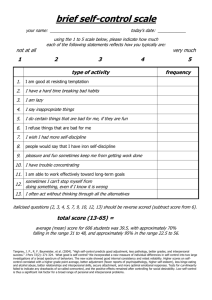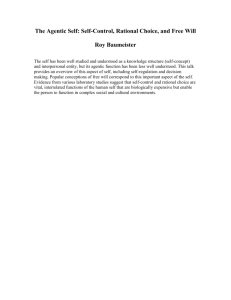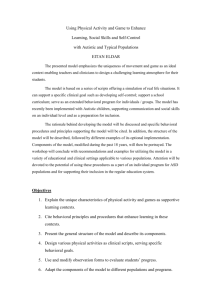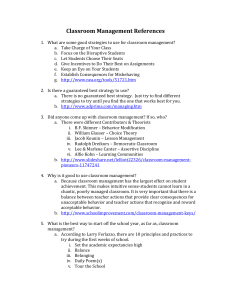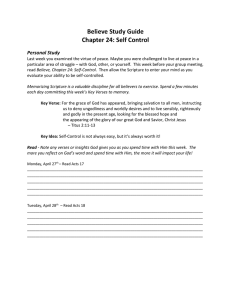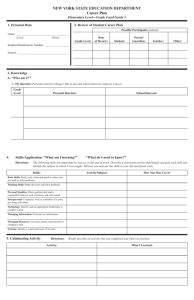EFFECT OF BEHAVIORAL SELF-CONTROL PROCEDURES OF
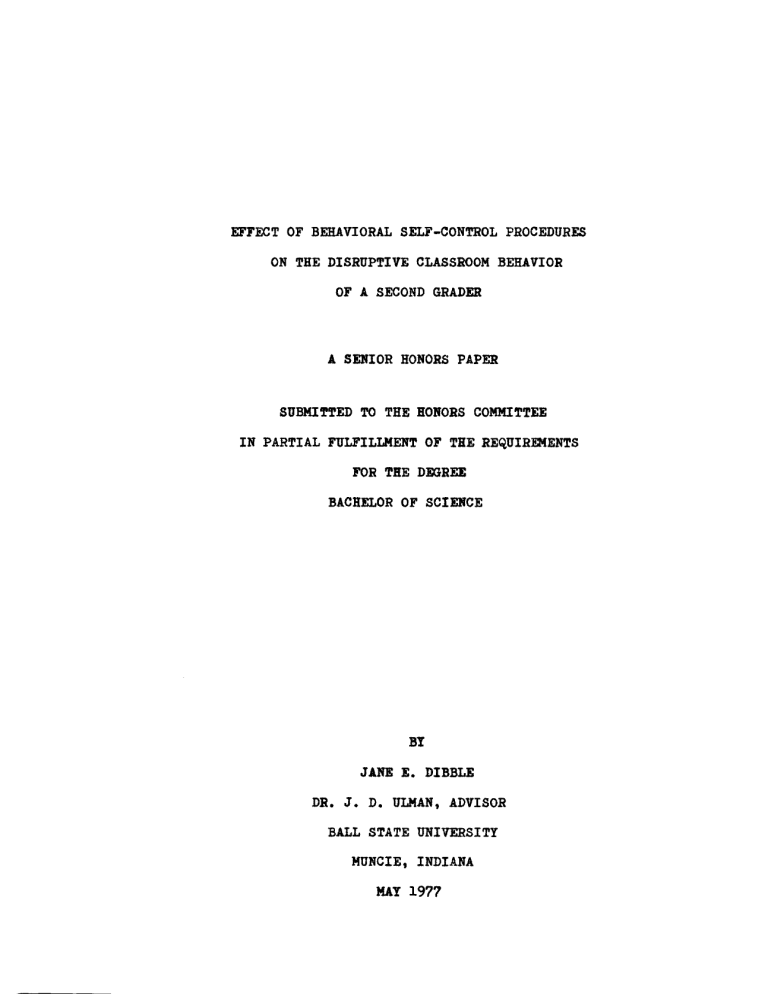
EFFECT OF BEHAVIORAL SELF-CONTROL PROCEDURES
ON THE DISRUPTIVE CLASSROOM BEHAVIOR
OF
A.
SECOND GRA.DER
A
SENIOR HONORS
PAPER
SUBMITTED
TO
THE BOBORS COMMITTEE
IN PARTIAL FULFILLMENT OF THE REQUIREMENTS
FOR TBE DmREE
BACHELOR OF SCIENCE
:BY
JANE E. DIBBLE
DR.
J.
D. ULMAN, ADVISOR
BALL STATE UNIVERSITY
MUNCIE, INDIANA
MAY 1971
<
• C \I
'.Ij> .t>
Thc~/r~;
L, Ii }
" 49,1
I
1~t'Jr)
• 'DE.3
CONTENTS
Illtroduction •
• • • • • • • • • • • • • • • • • • •
.1
Method
• • • • • • • • • • • • • • • • • • • • • • • • • •
5
Results
• • • • • • • • • • • • • • • • • • • • • • • •
8
Discussion • • • • • • • • • • • • • • • • • • • •
10
Reference List • • • • •
• • • • • • • • • • • • • • •
12
Self-control seems very easy to describe but hard to explain.
Traditionally people have attempted to explain self-control in term. of hypothetical functions of internal variables, using words such as "will power," "deterllination," "restraint t " etc. to describe such functions. Behaviorists have long placed the responsibility for behavior on external influences alone (Kurtz & Neisworth, 1976).
Emphasis on external influences comes from the presuppositions that Skinner (1953) advocated; that is, an individual "controls himself precisely as he would control the behavior of anyone else-through the manipulations of variables of which the behavior is a function (p. 228)." Skinner (1974) has more recently put forth the idea that self-control is a procedure in which an iD4ividual makes a response that alters the probability of the occurrence of another response.
Bandura (1969) approached the conflict between the traditional internal-variables view of self-control and the behavioral external-variables view of self-control by describing the relationship between the individual and the environment as continuous and mutually interacting (i.e., an individual alters his environment which in turn alters the individual). This dual interaction of behavior and environment can be thought of as a dynamic continuum which represents self-control (Thoresen & Mahoney, 1974).
Self-control has been conceptualized as covert in nature.
-2-
O'Leary and Wilson (1975) state that " • • • there is general agreement that self-controlling behaviors are a product of the same principles of control as are publicly acessible behaviors (p. 471)."
In short, self-control appears to refer to a covert behavioral process .hereby a person initiates and regulates his own behavior in an environment that is relatively free of external constraints.
In the last ten years there has been rapid growth in the area of behavioral self-control. The body of literature dealing with behavioral self-control studies conducted in classrooms has been rapidly growing (Lovitt & Curtiss, 1969; Glynn, 1970; Kunzelmann,
1970; Broden, Hall & Mitts, 1971; Glynn, Thomas & Shee, 1973; Glynn &
Thomas, 1974). Glynn's (1970) study and Broden, Hall and Mitts'
(1971) study were conducted with ninth grade girls and eighth grade students respectively. Glynn (1970) left open the question as to whether behavioral self-control procedures could be effectively employed with other populations than grade nine girls {e.g. younger children). Other researchers have tried to answer this question by conducting studies with younger children. Kunzelmann (1970) conducted a self-control experiment with a 7 year old girl with the objective of reducing whining behavior exhibited during school.
This study seems unique when compared with other behavioral selfcontrol stUdies in that only one child was used as the subject of the research. Bolstad and Johnson's (1972) study dealt with the disruptive classroom behavior of first and second grade students by comparing the effectiveness of externally administered reinforcement procedures and behavioral self-control procedures in controlling disruptive behavior. Glynn, Thomas. and Shee (1973)
-3employed behavioral selt-control procedures which were administered after an externally administered reinforcement program. The study sought to saintain on-task behavior at its ongoing high level and was conducted with primary school children.
In a related study Glynn and Thomas (1974) sought to show that behavioral self-control procedures may be employed successfully to reduce disruptive classroom behavior without first employing an externally administered reinforcement program. These studies seem to have been done in traditional classrooms. Lovitt and
Curtiss (1969) conducted a behavioral self-control study in a token economy classroom; the subject was a member of a class for children with behavioral disorders. It seems that there might be a lack of inforaation of the effectiveness of behavioral self-control procedures on normal children in open classroom settings.
The purpose of the present study was to analyze the effectiveness of self-control procedures on the disruptive, off-task behavior of one student in an open concept class. An attempt was made in this study to include the tollowing four components of behavioral self-control as put forth by Glynn, Thomas and
Shee (1973):
1. Self-assessment. The individual may examine his own behavior and decide whether or not he has performed a specific behavior or class of behaviors.
2. self-recordin,. The individual may objectively record the frequency of his performance of a given behavior or class of behaviors.
3. Self-determination of reinforcement. The individual may determine from all available reinforcers, the nature and amount of reinforcement he should receive contingent upon his performance of a given behavior or class of behaviors.
~-
4. Self-administration of reinforcement. The individual dispenses his own reinforcement (which mayor may not be self-determined) contingent upon his performance of a given behavior or class of behaviors.
(Glynn, Thomas & Shee, 1973, p. 105)
METHOD
Since one purpose of this study was to test the practicality of self-control programming in a typical open concept class, no observable adaptations were made by the teacher in her teaching methods or the content of the lessons.
The student was a 7 year old male member of a second grade class of an Indiana elementary school. The school was situated in a middle to lower economic area of a medium-sized town. There were 28 children in the class which was situated in the open area of an open concept school. Previously the teacher and the student teacher had experienced a great deal of difficulty in acquiring and holding the attention of the student. The student was frequently out of his seat and talking to other students during quiet work periods. The treatment procedures were applied to this student only. Observations were taken during reading in the morning which was from approximately 9:00 to 10:30 daily and during math in the afternoons which usually lasted 30 minutes at varying times of the afternoon.
Two of the student's behaviors were identified as being disruptive: being out of his seat and talking without peraission.
The behavior measured was as follows:
1. In-seat behavior. To be considered in-seat the student must remain in his chair with his feet on the floor.
The student could not move his chair more than six inches in any direction. The following were also considered to be in-seat behavior: a) When the subject was carrying his chair directly to or from a group activity. b) When the subject was sent on a specific errand that required him to walk by the teacher. c) When the subject had finished his reading work and had been granted peraission by the teacher, he was allowed to walk to the class library, select a
-6book, and return to his seat while still being considered as in-seat. otherwise the child was considered to be out of his seat.
2. Not-talking. To be considered as not talking the student must not say a word to anyone during reading and math periods. The following events were also defined as not-talking: (a) when asked a direct question by the teacher the subject was to answer the question, (b) when asked to read aloud by the teacher the s'udent was to comply and read aloud.
Using time-sample recording (Hall, 1974), the student's behavior was observed at the end of a time period of approximately fifteen minutes. Due to unfortunate circumstances, the student was only observed by the investigator during Phase I and there were no reliability checks during this phase. During Pbase II and
Phase III the student observed and recorded his own behavior with occasional reliability checks by the investigator. The student was cued to record his own behavior by the bell on a timer which sounded approximately every 15 minutes (range: 12 min. to 18 ain.) during each day's observation. Inter-observer reliability for Phases
II and III was calculated using point-by-point percentage agreement scores (Kelly, 1977): the number of sessions in which the two observers agreed divided by the total number of sessions observed by both observers x 100, resulting in percent of agreements between observers.
The three phases of this investigation cons*itute a simple comparison design, ABC (Miller, 1975): Phase I (or A) constitutes the baseline, Phase II (or B) and Phase III (or C) constitute the experimental phases.
Baseline--Pbase I: Prior to the recording of the baseline data, the investigator had been present in the class area for eight
-7school days. The child was not informed by the investigator that his behavior was being observed. For a period of ten school days baseline rates of on-task behavior were recorded. On-task behavior was considered to be in-seat and not-talking. The recording was done each day during reading and math periods and daily observation sessions ranged from 1 to
3
hours. During the two days before
Christmas vacation, recording was suspended because of interruptions.
In-seat--Phase II: During this phase in-seat behavior only constituted on-task behavior and was recorded for ten consecutive school days. At the beginning of the math and reading period the student was given one half of a
3
x
5
inch index card with the date, subject and the time the period began and ended written on the card.
A token reinforcement system was established: the investigator negotiated with the child to determine the number of points each of a series of high interest activities (games, puzzles, etc.) should cost. A timer was set out of the sight of the student, for an average period of fifteen minutes (between 10 and 20 min.).
The child earned one point each time he was on-task as the timer rang. Each morning the subject exchanged points from previous days.
In-seat and not-talking--Phase III: This phase was also conducted for ten consecutive school days. The token reinforce.ent procedures were identical to those employed in Phase II. When the timer bell rang the student gave himself a point if he was on-task, but now on-task behavior was considered to be in-seat and nottalking.
RESULTS
Average inter-observer reliability for Phases II and III was
92 percent; reliability during Phase II was 100 percent and during
Phase III was 86 percent. These two phases spanned a period of twenty consecutive school days. There were no reliability cheeks taken during Phase I (baseline).
During the baseline period the mean of on-task behavior was
49 percent. The student's on-task behavior ranged from 17 percent to 80 percent.
The student's mean was 64 percent on-task behavior during
Phase II. The on-task behavior of the student ranged from 40 percent to 75 percent.
During Phase III the student's mean of on-task behavior was
71 percent. The student had a range of 50 percent to 88 percent on-task behavior.
~
LU
V")
<{
I
!L
~
W t/)
<{
I
0-
H
LU
VI
«
~
N o
0
0 0 0 o en
CD oc:r
C\l
30N\iWMOJ~3d
)tS'Vl-NO.dO
3~\(lN3J~3d
~ t:
-
-
N
-
.0\
-
~(Jj
-«
.::rO
~
\t'1
('\£
V-
N rt')
N
0
N f\I
N -
C\I
!Z)
00
N f'.,.
N
<0
N
(X)
,.....
'>()
\t)
DISCUSSION
There was an increase in the student's on-task behavior as evidenced by the increase in the average mean from
49
percent during
Phase I (baseline) to 71 percent during Phase III. Several factors limit the interpretation of the results, however. The comparison design (Miller, 1975) of this investigation does not allow a functional relationship to be deterained. Thus, it is possible that increased rewards at home for academic achievement, attention from peers, or some other unidentified variable to have caused the increase in on-task behavior rather than the independent variable. The lack of an inter-observer reliability check during the baseline phase limits the interpretation of this investigation also. The fact that a different behavioral definition was employed during Phase II than during
Phases I and III does not allow comparisons between Phase II and the other two phases. Furthermore, during this investigation there were two vacations consisting of two weeks each, causing a long delay in time between the occurrence of reinforcable behavior and token-reinforcement exchange periods. Despite these limitations, this investigation offers some potentially useful information for classroom teachers.
The behavior change procedures used in this study required a minimum amount of time and effort on the part of the teacher, thereby making them as practical as possible. The preparation and distribution of the recording card required approximately fortyfive seconds and setting the timer required approximately fifteen seconds. The high interest activities (games, puzzles, etc.) had educational value and use of these activities at the beginning of
-11the school day put this "before school" time to an educational use.
The student seemed to experience an increase in social popularity during the morning token exchange periods. fhis may have been due to the fact that 80me of the educational games required the student to choose other students to participate. Moreover, there was marked increase in the student's output of academic work. The increase ia the student's on-task behavior was so noticeable that the teacher and aide commented on the student's improving work habits and noted that he nwas doing much better in other areas" as well.
Since a functional relationship between the dependent and independent variables was not verified in this investigation, conclusive generalizations are inappropriate. The fact that only one child was used as the subject leaves open the question of generalizability; that is, whether the same results would have been obtained with other children. The small variety of reinforcers used also opens the question as to whether the same results would have been obtained with a wider variety of reinforcers. The use of an adequate design, use of the same behavioral definition throughout the investigation, and replication of the procedures described will be necessary to determine scientifically whether these selfcontrol procedures will be valuable tools for teachers in openconcept schools. Given the magnitude of the change in behavior from
Phase I to Phase III, and the ease with which the self-control procedures were implemented, the need for further research is apparent.
REFERDCE LIST
Bandura, A. Principles of Behavior Modification. New York:
Holt, Rinehart & Winston, 1969.
Bolstad, O. & Johnson, S. Self regulation in the .odification of disruptive classroom behavior. Journal ~
Behavior Analysis, 1972. 5, 443-454.
Broden. M. & Hall, R. & Mitts, B. The effect of self-recording on the classroom behavior of two eighth-grade students.
Journal ~ ~, 191-199.
Glynn, E. Classroom applications of self-deter.ined reinforcement.
Journal
!!
Applied Behavior Anallsis, 1970, ~, 123-132.
Glynn, E. & Thomas, J. Effect of cueing on self-control of classrooa behavior. Journal of Applied Behavior Analysis, 1974.
1,
299-306.
Glynn, E. & Thomas, J. & Shee, S. Behavioral self-control of ontask behavior in an elementary classroom. Journal of Applied
Behavior AAallSis, 1973, ~. 105-113.
Hall, R. Manaling Behavior. Lawrence: H
1974.
& B Enterprises, Inc.,
KellYt M. A review of observational data-collection and reliability procedures reported in the JourAal of APElied Behavior Anallsis.
Journal ~
12.
97-101.
Kunzelmann, B. (ed.) Precision Teaching. Seattle: Special Child
Publications, 1970.
Kurtz. P. & Neisworth, J. Self-control possibilities for exceptional children. Exceptional Children, 1976, ~, 212-216.
Lovitt, T. & Curtiss, K. Acadeaic response rate as a function of teacher and self-imposed contingencies. Journal ~
Behavior Anallsis, 1969, ~, 49-53.
O'Leary. K. & Wilson, G. Behavior Therapy. Englewood Cliffs:
Prentice-Ball, Inc., 1975.
Miller, L. Principles!! Everydal Behavior Anallsis. Monterey:
Brooks/Cole Publishing Co., 1975.
Skinner, B. Science and Human Behavior. New York: Macmillan Co.,
1953.
Skinner, B. About Behaviorism. New York: Alfred A. Knopf, 1974.
Thoresen, C. & Mahoney, M. Behavioral Self-Control. New York:
Holt, Rinehart & Winston, Inc., 1974.
